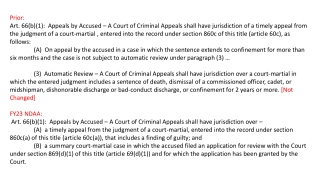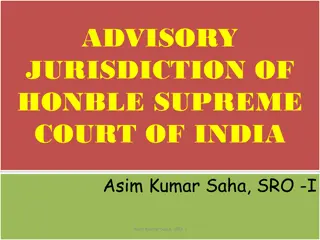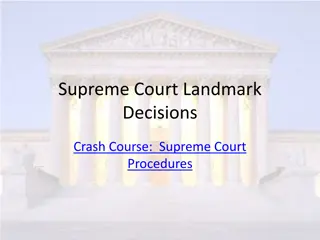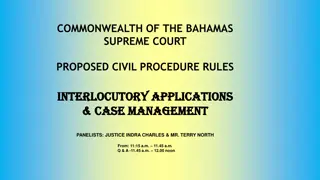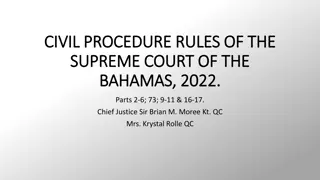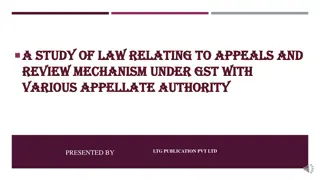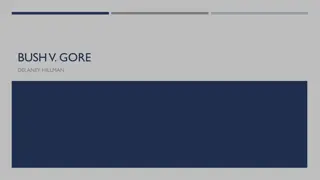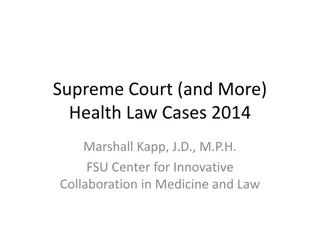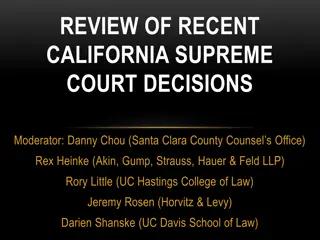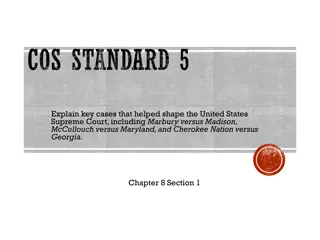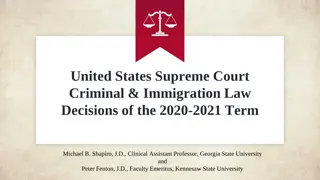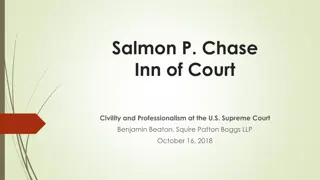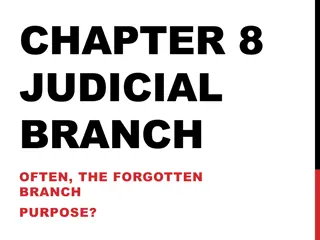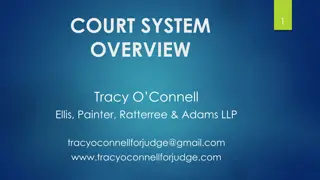Understanding the California Supreme Court Review Process
Explore the workings of the California Supreme Court in considering petitions for review, filing statistics, and the challenges faced by litigants seeking review. Learn about the criteria for selecting petitions, filing statistics, and client considerations in pursuing a petition. Discover the small chances of getting a petition for review granted and additional requirements for criminal petitions.
Download Presentation

Please find below an Image/Link to download the presentation.
The content on the website is provided AS IS for your information and personal use only. It may not be sold, licensed, or shared on other websites without obtaining consent from the author. Download presentation by click this link. If you encounter any issues during the download, it is possible that the publisher has removed the file from their server.
E N D
Presentation Transcript
GET YOUR REVIEW PETITION GRANTED David Kaiser, California Supreme Court Aimee Feinberg, California Department of Justice Dennis Maio, Reed Smith Myron Moskovitz, Moskovitz Appellate Team
COURT AND GOVERNMENT EMPLOYEES APPEARING ON THIS PANEL DO SO IN AN EDUCATIONAL CAPACITY ONLY. ANY VIEWS EXPRESSED BY THEM ARE NOT THOSE OF THE COURT OR ANY GOVERNMENTAL ENTITY. THE PARTICIPATION OF PRIVATE PRACTITIONERS HERE NEITHER CONSTITUTES AN ENDORSEMENT BY THE COURT NOR INDICATES THAT PETITIONS FOR REVIEW PREPARED BY SUCH PRACTITIONERS ARE VIEWED WITH GREATER FAVOR THAN THOSE PREPARED BY ANYONE ELSE.
OVERVIEW I. How the Supreme Court of California works now. Not a court of error correction. The criteria for selecting petitions for review: conflict or important questions of law. II. Proposals to expand the court s role to expressly include being a court of at least limited error correction. (A) Summary dispositions. (B) Focused grant and transfer orders.
FILING STATISTICS IN THE LAST FEW YEARS About 1,000 civil petitions for review per year About 3,000 criminal petitions for review per year
SMALL CHANCES FOR GETTING A PETITION FOR REVIEW GRANTED Civil grant rate about 2-3% Criminal grant rate about 1%
CALIFORNIA RULES OF COURT, RULE 8.500(B)(1) The Supreme Court may order review of a Court of Appeal decision: (1) When necessary to secure uniformity of decision or to settle an important question of law;
CLIENT CONSIDERATIONS IN PURSUING A PETITION FOR REVIEW 1. Typical Client 2. Sophisticated or Institutional Client 3. Governmental Client
ADDITIONAL CONSIDERATIONS IN DECIDING TO FILE A CRIMINAL PETITION FOR REVIEW Exhaustion requirement for federal habeas relief. [S]tate prisoners must give the state courts one full opportunity to resolve any constitutional issues by invoking one complete round of the State s established appellate review process. (O Sullivan v. Boerckel (1999) 526 U.S. 838, 845.) This usually means a petition for review with the California Supreme Court.
RULE OF COURT 8.508 ALLOWS AN EXHAUSTION PETITION, WHOSE SOLE FUNCTION IS TO PRESERVE AN ISSUE FOR FEDERAL REVIEW Rule 8.508: Petition for Review to Exhaust State Remedies (a) Purpose. After decision by the Court of Appeal in a criminal case, a defendant may file an abbreviated petition for review in the Supreme Court for the sole purpose of exhausting state remedies before presenting a claim for federal habeas corpus relief.
PART II. PROPOSALS TO EXPAND THE COURTS ROLE AS TO ERROR CORRECTION Anthony Kline & Jerome B. Falk, Opinion: Making law in the dark, S.F. Daily Journal (Aug. 8, 2016). Cruz Reynoso & Stephen Greenberg, A New Ground for Review and Transfer, S.F. Daily Journal. (Aug. 2, 2016)
1. SUMMARY DISPOSITIONS. Fast Track decisions. Per curiam opinions without oral argument. Based on the practice of the United States Supreme Court, which sometimes issues per curiam opinions based on the cert petitions and briefs in opposition without further briefing and without oral argument.
2. FOCUSED GRANT AND TRANSFER ORDERS. The petition for review is granted. The matter is transferred to the Court of Appeal with directions to vacate its decision and reconsider the cause in light of [specified case or doctrine of law] or [specified facts in the case].
EXISTING AUTHORITY. BROAD DISCRETION IN GRANT AND TRANSFER. California Rule of Court, rule 8.528(d) After ordering review, the Supreme Court may transfer the cause to a Court of Appeal without decision but with instructions to conduct such proceedings as the Supreme Court orders.
ARE THESE SOLUTIONS IN SEARCH OF A PROBLEM? ARE THERE PROBLEMS IN COURT OF APPEAL OPINIONS THAT ARE NOT ADEQUATELY ADDRESSED THROUGH CURRENT PROCEDURES SUCH AS A PETITION FOR REHEARING IN THE COURT OF APPEAL?


